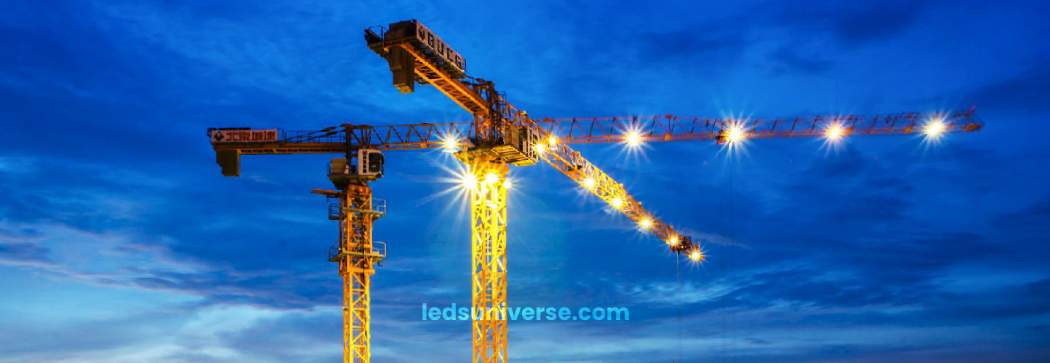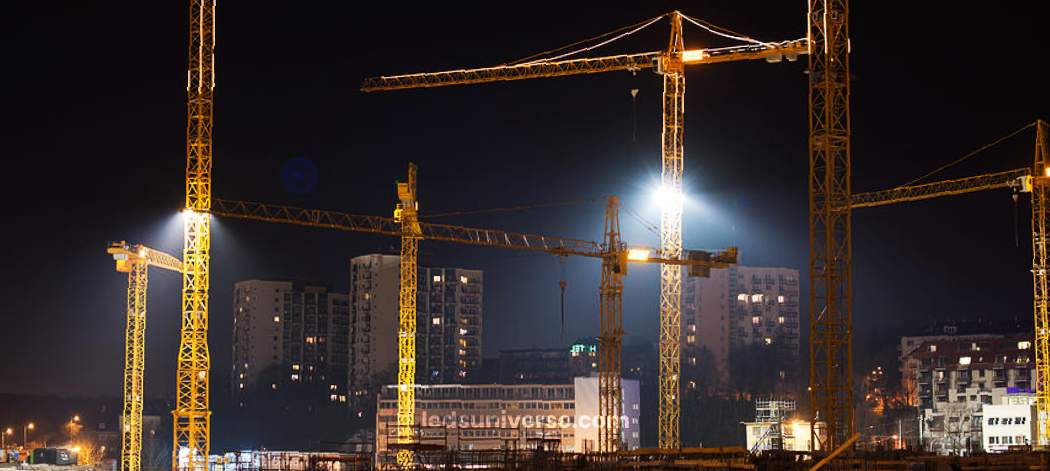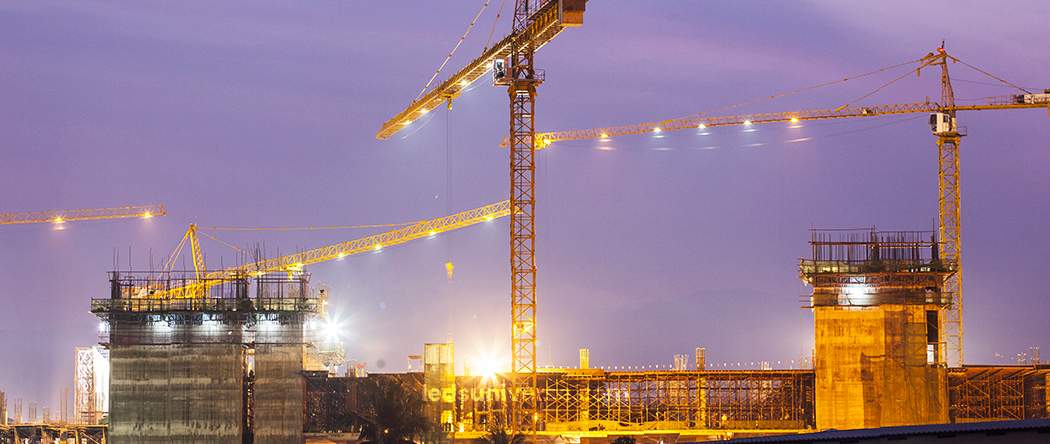
As daylight fades on a construction site, cranes continue their heavy lifting. Without proper lighting, operators struggle to see, and workers on the ground face increased risks. Effective crane lighting ensures visibility, safety, and smooth operations, even in low-light conditions. Let’s explore how the right lighting solutions can make all the difference.
These large, powerful machines are responsible for lifting and moving heavy loads at great heights, often in challenging environments. Proper illumination not only assists crane operators in performing their tasks accurately but also ensures that workers on the ground can monitor crane movements, reducing the risk of accidents. Adequate lighting enhances visibility during both day and night operations, creating a safer work environment and increasing productivity.
Reach out for free lighting consultation
Table of Contents
ToggleCranes operate under diverse and sometimes hazardous conditions, which demand appropriate lighting for safe and efficient functioning. The operators rely heavily on visibility to manage complex tasks, ensuring the safe transport of materials. At the same time, ground workers need clear sightlines to monitor crane operations and avoid potential hazards. Effective lighting solutions allow crane operators to accurately judge distances, assess the load, and avoid obstacles during lifts.
Lighting also plays a role in enhancing productivity by facilitating the uninterrupted progress of work after sunset or in low-light conditions. Many construction projects extend into the night, and without proper lighting, the performance of tasks could slow down or even come to a halt, resulting in delays. Moreover, well-lit environments allow for better communication and coordination between workers, ensuring that everyone remains aware of crane movements and tasks being performed.
The risk of accidents can increase significantly in poorly lit environments, particularly on construction sites where large equipment, such as cranes, is in constant motion. Inadequate lighting can obscure critical details, making it difficult for operators to assess their surroundings. On the ground, workers might not see the crane’s load clearly, leading to dangerous situations.
By implementing well-planned lighting systems, the likelihood of accidents can be minimized. For instance, cranes equipped with focused lighting provide operators with a clear view of the load and the surrounding environment. Ground-level lighting can illuminate pathways, ensuring that all workers have a clear visual of ongoing crane operations. Specialized lighting systems may also be used to highlight specific tasks, such as loading and unloading materials, ensuring precision and efficiency in handling.

Given the diversity of crane operations, several lighting solutions are available to meet the demands of various tasks. From floodlights that illuminate wide areas to work lights that focus on precision tasks, each type of light has its unique advantages. Below are some of the most effective lighting options for cranes.
LED floodlights are widely used on construction sites and for crane operations due to their energy efficiency, long lifespan, and durability. LED technology produces a powerful, broad beam of light, making it ideal for illuminating large areas. These floodlights can be mounted on cranes, towers, or other structures to provide a wide range of visibility during nighttime operations or in low-light conditions.
One of the advantages of LED floodlights is their adaptability. Depending on the situation, they can be powered by a direct power connection, a battery, or a solar panel, making them suitable for remote locations. Some LED floodlights also offer additional features like dimming options, allowing operators to control light intensity as needed.
LED work lights are designed for tasks that require focused lighting, such as inspections or detailed repairs. These lights provide a concentrated beam, which helps workers maintain a clear view of the task without being distracted by unnecessary illumination. Like floodlights, LED work lights are energy-efficient and long-lasting, making them an excellent choice for continuous use.
LED work lights can be mounted directly on the crane or placed on a separate stand, offering flexibility depending on the application. Some models also feature adjustable beam angles and color-changing capabilities, enhancing their usability in different environments and tasks.
In situations where access to power is limited or nonexistent, solar-powered lights provide a sustainable and efficient solution. These lighting systems consist of a solar panel, a rechargeable battery, and a light fixture. During the day, the solar panel absorbs sunlight and converts it into electrical energy, which is stored in the battery. At night or in low-light conditions, the stored energy powers the light.
Solar-powered lights are especially useful for crane operations in remote locations. They can serve as either floodlights or work lights, depending on the design and application. However, one drawback of solar-powered lights is their dependence on sunlight. During cloudy days or in low-light environments, the efficiency of these lights may diminish, requiring supplemental lighting solutions.
Battery-powered lights offer a convenient and portable solution for crane lighting, especially when cranes operate in areas without direct access to power sources. These lights can be used for both floodlighting and task-specific work lighting, depending on the model. Powered by rechargeable batteries like lithium-ion or lead-acid, they provide consistent lighting for extended periods.
One of the key benefits of battery-powered lights is their flexibility. They can be moved and repositioned easily, making them ideal for dynamic work environments. However, regular maintenance is required to recharge or replace batteries, depending on the usage patterns and the battery type.

Selecting the right lighting for cranes requires consideration of various factors, such as brightness, durability, power source, and cost. These factors ensure that the lighting system chosen is both functional and economical, providing reliable performance under challenging conditions.
Brightness is one of the primary considerations when selecting lighting for cranes. Measured in lumens, it refers to the amount of light emitted by a fixture. Tasks that require broad illumination, such as site-wide crane operations, may need higher-lumen output to ensure the entire work area is visible.
The beam angle is another important factor. It determines the spread of the light beam. A wide beam angle is suitable for covering large areas, whereas a narrower beam angle works best for tasks that require concentrated illumination, such as precision lifting or inspections. Choosing the appropriate beam angle ensures that the lighting solution meets the specific requirements of the crane operation.
Color temperature refers to the hue of the light produced by a fixture and is measured in degrees Kelvin (K). Different color temperatures are suitable for different tasks. Higher color temperatures produce a cooler, bluish light that enhances visual clarity, making them ideal for tasks like inspections or repairs. Lower color temperatures, which create a warmer, yellowish light, may be more comfortable for general visibility or less demanding tasks.
Choosing the right color temperature for crane lighting depends on the nature of the work being performed. Cooler temperatures improve focus and visibility in detailed tasks, while warmer tones provide general lighting for larger areas without causing visual fatigue.
Cranes are often deployed in environments where they are exposed to weather extremes, rough handling, and physical impacts. Therefore, lighting fixtures must be robust and able to withstand these conditions. Lighting designed for crane operations should be made from materials such as stainless steel or aluminum, which are resistant to corrosion and physical damage.
Weatherproofing is another crucial factor to consider, particularly in outdoor environments where moisture, dust, and temperature fluctuations are common. Fixtures that are sealed against environmental elements ensure uninterrupted operation, regardless of the conditions.
The choice of power source plays a significant role in selecting crane lighting. In remote areas, where access to electricity is limited, portable power solutions such as solar or battery-powered lights are essential. Solar-powered lighting is particularly useful in sunny environments, while battery-powered options offer flexibility in various settings.
For cranes operating in urban areas or construction sites with access to electricity, traditional power sources can be used to power lighting systems. However, hybrid systems that combine both traditional and alternative power sources may be beneficial, providing a backup in case of power outages.
The upfront cost of crane lighting systems is an important factor, but it should be weighed against the long-term benefits. LED lighting, for instance, tends to have a higher initial cost compared to traditional lighting technologies but offers significant energy savings and a longer lifespan. These factors reduce the total cost of ownership over time.
Additionally, ongoing maintenance costs, such as battery replacement or fuel for generators, should be considered. By evaluating both short-term and long-term costs, construction managers can select lighting systems that provide the best value for their operations.

While lighting is necessary for crane operations, there are several challenges to providing consistent and effective illumination. The nature of crane operations, often in difficult-to-reach or remote locations, limits access to traditional power sources. Additionally, cranes are subject to environmental extremes, requiring durable and resilient lighting solutions that can withstand harsh conditions.
One of the primary challenges in lighting cranes is the limited access to power sources. Cranes often operate in locations where there are no nearby power outlets or electrical grids, such as remote construction sites, bridges, or high-rise buildings. In such cases, traditional lighting solutions like incandescent or halogen lamps, which require a direct power connection, become impractical.
To address this, lighting solutions that are independent of permanent power sources should be considered. Portable and alternative power sources, such as batteries or solar panels, offer flexible options for crane lighting. Battery-powered lights can be recharged and used over extended periods, while solar-powered lights are particularly useful in environments with ample sunlight. These types of lighting systems not only ensure continuous operation but also reduce dependence on generators or fuel-powered alternatives.
Cranes operate in challenging environments, where they are exposed to extreme weather conditions, heavy vibrations, and rough handling. As a result, lighting solutions need to be durable and rugged to ensure consistent performance. Lights installed on cranes must withstand temperature fluctuations, moisture, dust, and physical impacts. Choosing the right materials and designs for lighting fixtures is crucial to their longevity.
Lighting systems designed for crane operations often incorporate robust materials, such as stainless steel or aluminum, to provide protection against corrosion and mechanical damage. Furthermore, weatherproofing and sealing mechanisms prevent moisture and dust from affecting the light’s internal components. The lighting should also resist vibration, as cranes often move loads and experience shifts in position, which could displace or damage less sturdy fixtures.
Cranes are used in a wide range of tasks, from construction to material handling, each requiring different lighting setups. As a result, lighting solutions for cranes must be versatile and flexible to accommodate various tasks and environments. For example, while large construction sites may require floodlighting to cover vast areas, specific tasks like load inspection may benefit from more focused beam lighting.
Lighting systems that offer adjustable beam angles, tripod mounts, or modular designs enable workers to configure the lights according to the task at hand. Some lighting fixtures allow for easy repositioning and adaptation, enhancing their usability in different scenarios. Lights with dimming or color-changing capabilities further extend their versatility, allowing operators to adjust the lighting based on specific visibility needs.
Given the diverse challenges faced by cranes, selecting the appropriate lighting solution requires careful consideration of factors such as power sources, durability, brightness, and cost. With advances in technology, a range of lighting options—such as LED, solar-powered, and battery-powered lights—are available to meet the specific needs of crane operators and ensure optimal performance under varying conditions.